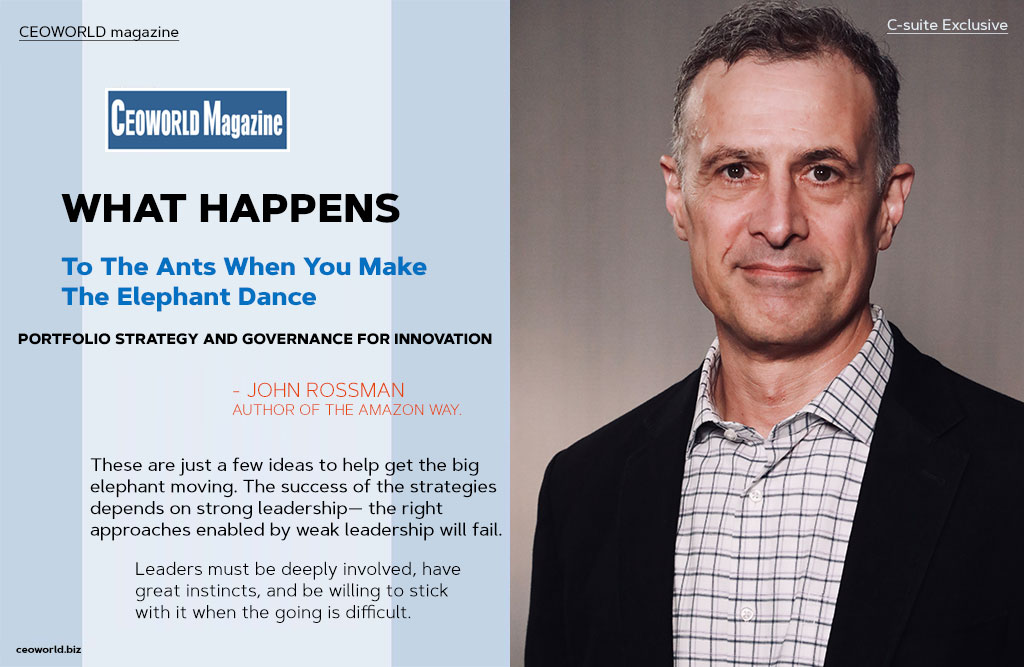What Happens To The Ants When You Make The Elephant Dance

Portfolio Strategy and Governance for Innovation.
“It isn’t a question of whether elephants can prevail over ants. It’s a question of whether a particular elephant can dance. If it can, the ants must leave the dance floor.” —Louis V. Gerstner, Jr.
How does a company the size of Amazon consistently innovate? They don’t “hope” for innovation, they have a system for innovation. They focus on the inputs trusting that the outputs will come. How do you get an elephant to dance?
If you study Amazon as I have, you will realize that there are a few tricks and approaches that can help an elephant—or any other company —innovate.
The most important decisions executive management makes is where to put its resources. The essence of strategy is deciding what to say yes to and what to say no to. As in any investment portfolio, there are likely low-risk, low-reward investments, and higher-risk, higher-reward investments. Here are a few tips.
INVEST LIKE A VENTURE CAPITAL FIRM AND CREATE AN INNOVATION PORTFOLIO
Many companies squash innovation and invention because they want predictable results—a predictable time frame, predictable investment, predictable financial returns with moderate risk. This is how a private equity company invests. There are times when this is the right mentality.
For example, you should understand the returns and risks when improving and automating an internal process, building a new distribution center, or implementing a marketing system.
These should have a clear business case and understanding as to what is needed for success to happen. But when you’re creating new, innovative customer features or developing new business lines, your investments, risks, and returns will be harder to predict. In this case, the job of a successful innovator is to act like a venture capital firm.
The key is maintaining a balanced investment portfolio and understanding the differences among its segments. High-risk investments need to be small experiments to prove key aspects before scaling. Think big but act small.
DEDICATE A SENIOR, CAPABLE LEADER TO INITIATIVE
At many companies, you can identify a leader’s cachet by the headcount and expense budget he or she manages. Not so at Amazon, where senior people are often dedicated to leading new big bets. This has a unique and clever name – a single threaded leader. This leader “obsesses” about driving the initiative to success.
They need to be senior enough to have reach and influence in the organization and know how to get things done. But what typically happens at companies — senior leaders are not “single threaded” and the “big bet” is just one objective on their list, and typically is not the most important priority.
CRAFT THE RIGHT METRICS AND GOALS
Spend significant time debating and designing the metrics and measures for the initiatives. The most important are customer experience metrics and adoption metrics. At Amazon, we spent as much time debating and designing the metrics for the initiative as we would on the actual design.
It’s fine to try to craft the overall business case, but early on the real financial metric to be understanding is unit economics – customer acquisition costs, order fulfillment cost, lifetime value of a customer. Forecast where these unit economics have to trend in order to have the right gross margins in the business — these are then the goals for scaling. Understanding addressable market is key early on, but actual business cases might be both impossible as well as misleading.
BUILD SMALL, INTEGRATED, MULTIDISCIPLINARY TEAMS
Amazon has two rules of thumb for building teams that think and act innovatively. The first is to create a team composed of people with a variety of disciplines and backgrounds. Unique ideas and the ability to execute on them usually stem from teams that can think broadly.
The second rule of thumb is to focus on small teams. Amazon often quantifies this as a “Two-Pizza Team.” In other words, you should be able to feed your whole team with two pizzas. That means no more than 8 to 10 people. Two-Pizza Teams not only own a capability. They’re also responsible for everything from the market definition and product road map to the building and operations. (See Idea 20, “Pizza for All!”)
CREATE AN INSANELY BETTER PRODUCT OR SERVICE
In the end, the above ingredients cannot yield a merely good product or service. It must be insanely good. Like jaws-to-the-floor good. This is not about marginal improvement. This is not a “completely new, but still average” product. Successful innovation results in an incredible experience—at the right price point. It surprises users, and it very quickly becomes indispensable to your customers. New products and features win in market because they solve a customer problem, pain-point and have “killer features”.
This needs to be the focus of your innovations – the customer and the problem you are going to solve for them. Before you build anything, work to gain clarity on that this “customer superpower” is. At Amazon, we talked about “starting with the customer and working backwards”. By writing narratives, future press releases, FAQ’s and low fidelity prototyping, we were working to better understand the customer, their job to be done, and how we were going to delight them.
These are just a few ideas to help get the big elephant moving. The success of the strategies depends on strong leadership— the right approaches enabled by weak leadership will fail. Leaders must be deeply involved, have great instincts, and be willing to stick with it when the going is difficult.
Written by John Rossman.
Add CEOWORLD magazine to your Google News feed.
Follow CEOWORLD magazine headlines on: Google News, LinkedIn, Twitter, and Facebook.
Copyright 2024 The CEOWORLD magazine. All rights reserved. This material (and any extract from it) must not be copied, redistributed or placed on any website, without CEOWORLD magazine' prior written consent. For media queries, please contact: info@ceoworld.biz








